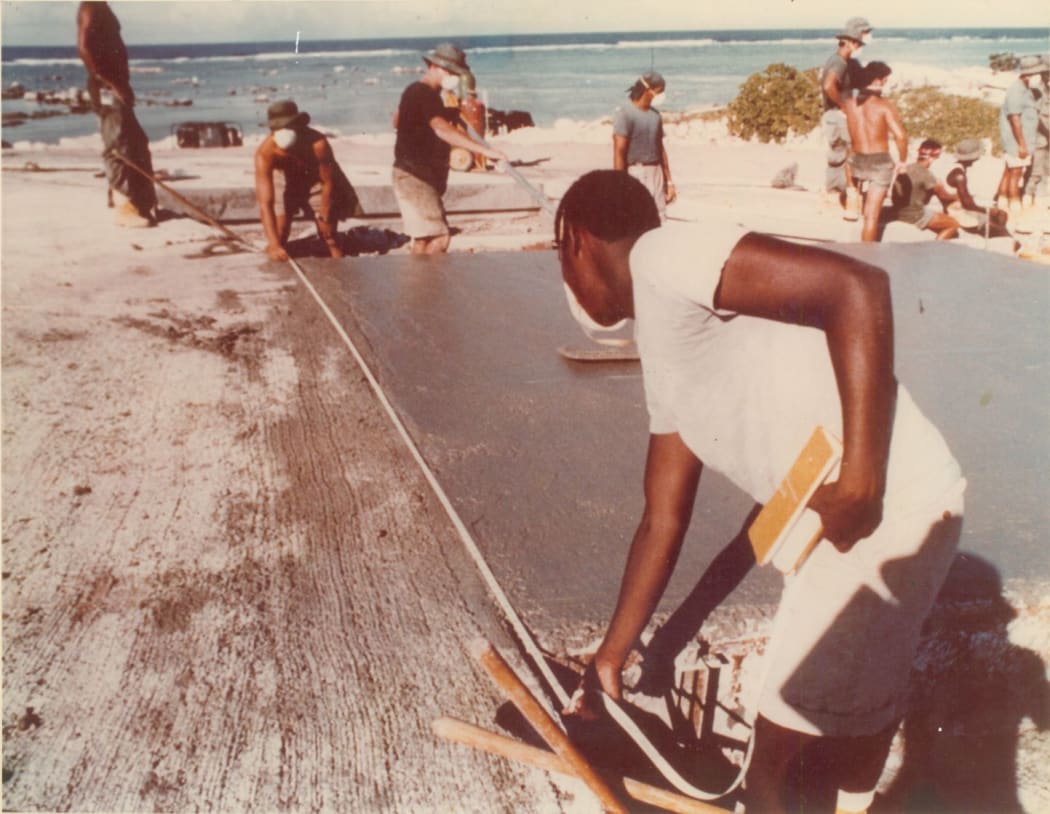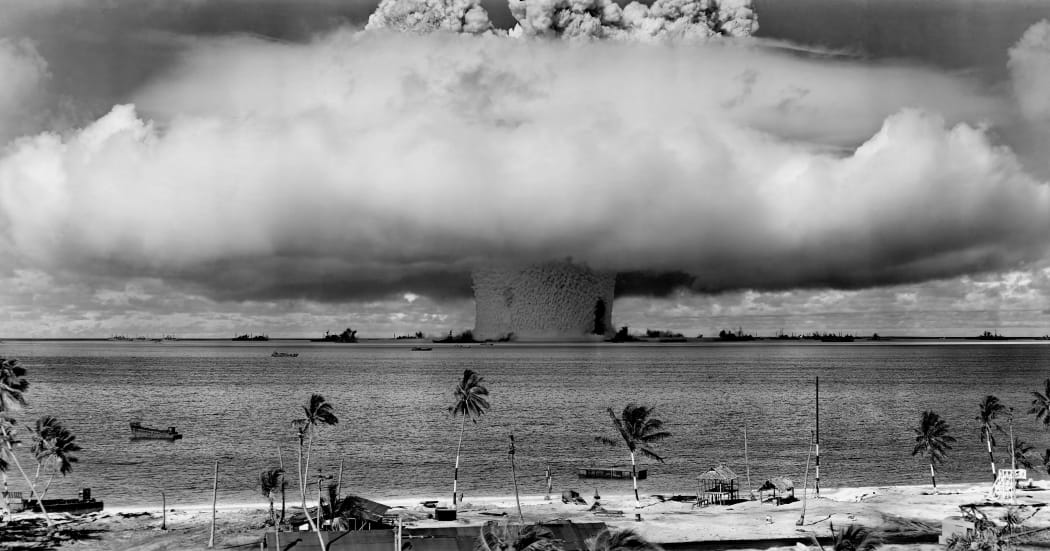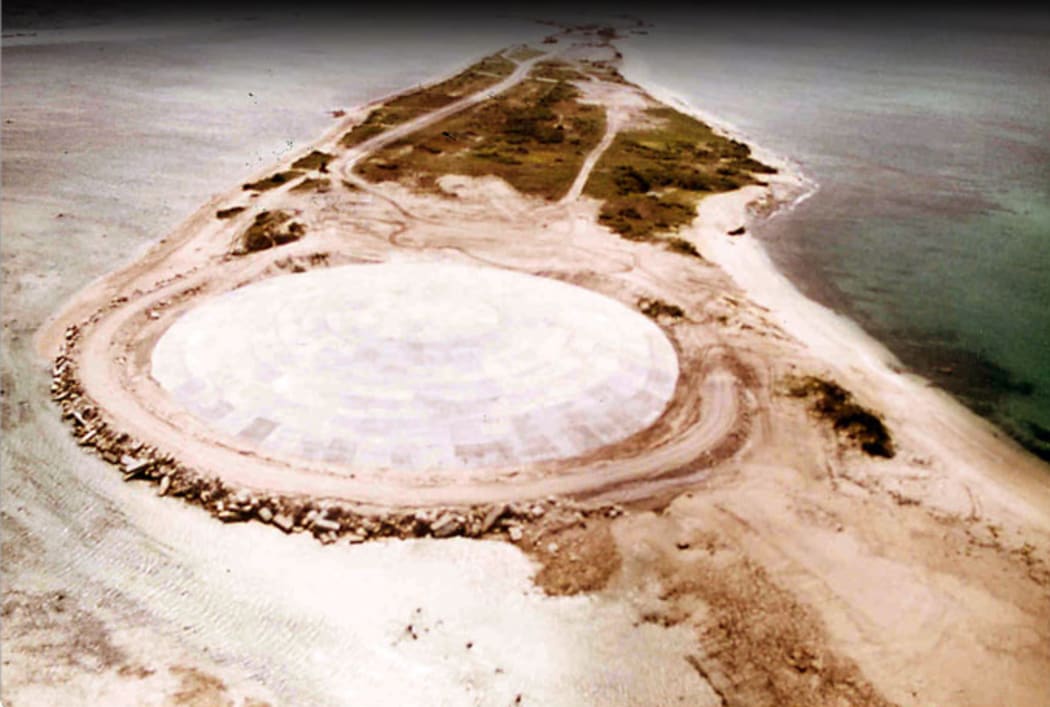A new scientific report suggests that the radioactive element strontium 90 is a more significant contamination factor in the northern Marshall Islands than has been acknowledged to date by the US Department of Energy.

.Runit dome Enewetak: Sediments near the Runit Dome nuclear waste storage facility in Enewetak Atoll show high levels of radioactive strontium 90, a nuclear test byproduct that a new scientific report said has been largely ignored by US government-sponsored studies. Photo: Giff Johnson
The new study, published in the Journal of Radiation Research and Applied Sciences earlier this month, zeroes in on strontium 90, which it says has been largely ignored by US government scientists who have focused decades of studies on cesium 137 as the primary contributor to radiation exposure for Marshallese living on contaminated islands.
"In the case of the Marshall Islands, strontium 90 has largely been ignored in favour of a focus on cesium 137," the new report said.
"For example, the Department of Energy's (DOE) recent report to Congress on the status of the Runit Dome makes only a single reference to strontium 90, even while acknowledging that it is one of the key extant radionuclides in the Marshall Islands."
In the 1970s, the DOE determined that cesium 137 accounted for 95 percent of the potential radiation exposure from land and focused its scientific work on cesium 137.
Authors Hart Rapaport, Ivana Nikolic-Hughes and Emlyn Hughes, all of whom are associated with the K=1 Project at the Center for Nuclear Studies, Columbia University in New York City, said that while there has been significant study of the after effects of the 67 US nuclear weapons tests in the Marshall Islands, little has been reported about strontium 90 contamination.
"Sediment cores from the Bravo test crater in Bikini Atoll and Lacrosse crater near Runit Island (Enewetak Atoll) were assessed for strontium 90 and cesium 137 concentrations, which were found to be measurable in all cores," the authors said.
"Ratios of strontium 90/cesium 137 are elevated compared to values measured previously at other sites of weapons testing and nuclear accidents.

The "Baker" explosion, part of Operation Crossroads, a nuclear weapon test by the United States military at Bikini Atoll, Micronesia, on 25 July 1946. Photo: PD
These findings suggest the need to further investigate strontium 90 concentrations in the northern Marshall Islands to assess the safety of current residents in light of the potential for strontium 90 conveyance and to provide input regarding resettlement of currently unoccupied islands and atolls."
The authors note that strontium 90 is "well recognised as a source of major health risk at other sites," including in Fukushima, Japan which was the site of a nuclear power plant disaster in 2011.
Like cesium 137, strontium 90 "once in soil or sediment, presents a danger to humans because of plant uptake (and eventual conveyance into food sources) as well as atmospheric contamination," said the newly published study that is based on samples collected from Bikini and Enewetak in August 2018.
"To our knowledge, there exist few other published data on strontium 90 content in the Marshall Islands," the authors said.
"These results provide further demonstration of the continuing impact of radioactive fallout on the Marshall Islands…"
The authors said they could find no US government or institutional guidelines for "permissible levels" of strontium 90 in ocean sediment. But there are safety guidelines for strontium 90 in food.
The new study points out that strontium 90 limit for food set by the US Food and Drug Administration is 160 Bq/kg, well below the level of 1,200 Bq/kg for cesium 137.

In the late 1970s, US Army personnel constructed the nuclear waste storage facility now known as the Runit Dome at Enewetak Atoll. The US-sponsored nuclear cleanup of Enewetak concluded in 1980, with only a few of the islands at the former nuclear test ground zero cleaned up. Photo: Giff Johnson
The authors discuss an earlier US government scientific evaluation showing that some fruits on Bikini have levels of cesium 137 higher than the FDA food safety limit.
"Given that strontium 90 concentrations found in ocean sediment are much higher than cesium 137 concentrations, it is possible that strontium 90 levels in food sources across impacted islands are above the FDA imposed limit," the study said.
"Future work to assess the level of strontium 90 contamination in sediment, soil, and fruit from the Marshall Islands is of paramount importance."
The authors point out that their work is preliminary and urged follow up.
"The most pertinent conclusion is a suggestion for further study to establish updated strontium 90 concentrations in soil, sediment, and fruit as well as to provide current assessments for how this radionuclide impacts the health of the people of the Marshall Islands," they said.
"Much of the previous data of this type are now decades old, which raises the specter of inaccurate estimates on a vital topic."
With the focus of the US Department of Energy and its predecessor agencies on cesium 137, strontium 90 has not received much attention, they said.


